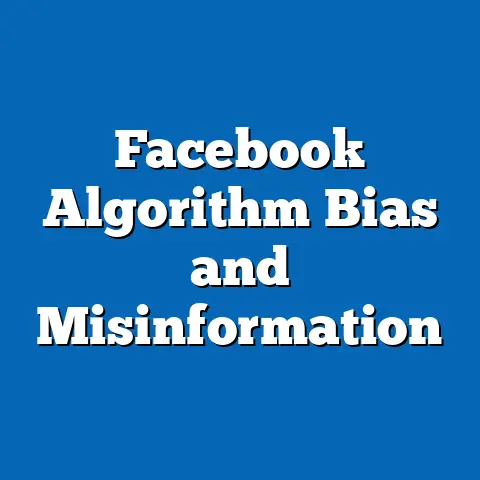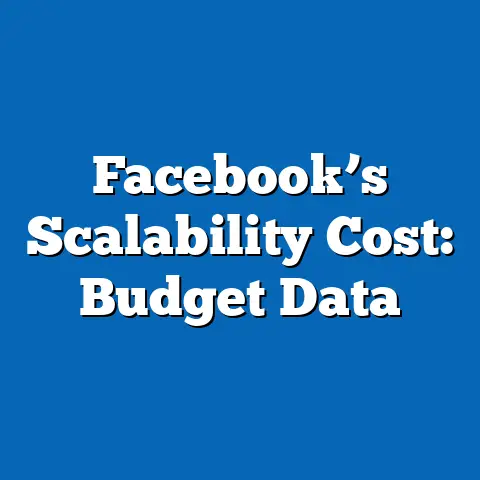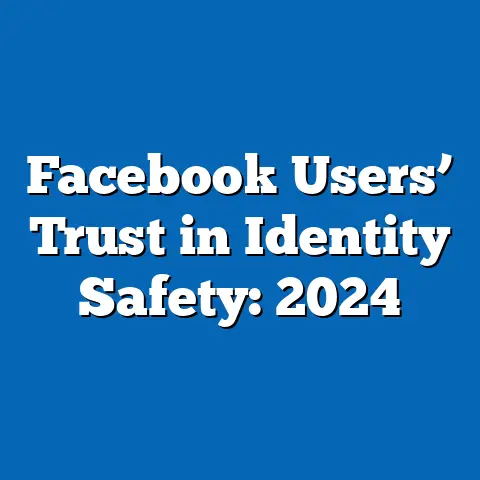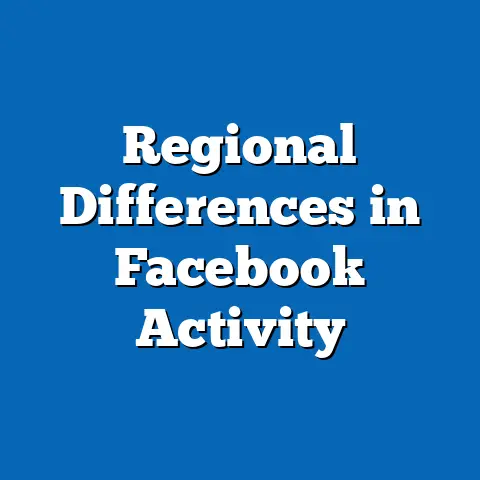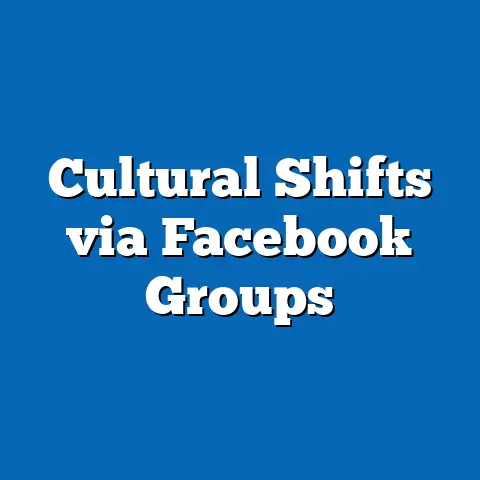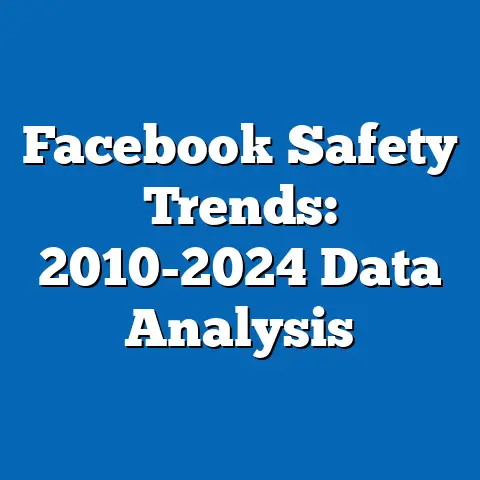Impact of Facebook Algorithms on News Trust
In an era dominated by social media, a pervasive problem has emerged: the spread of misinformation and the decline in public trust in news sources, largely influenced by how algorithms on platforms like Facebook prioritize content. For instance, a 2023 Pew Research Center survey revealed that only 26% of U.S. adults have a great deal or fair amount of confidence in the accuracy of national news organizations, down from 31% in 2016. This erosion of trust is exacerbated by Facebook’s algorithms, which personalize news feeds based on user behavior, often creating echo chambers that reinforce biases and amplify unreliable information.
Demographically, younger adults and certain minority groups are particularly affected. According to the same Pew survey, 54% of U.S. adults aged 18-29 get news from social media at least sometimes, compared to just 28% of those aged 65 and older. Moreover, a 2022 Reuters Institute Digital News Report highlighted that in countries like the UK and Brazil, Black and Hispanic users are more likely to encounter misleading content on Facebook, with 45% of respondents from these demographics reporting frequent exposure to unverified news. These trends underscore a growing divide, where algorithmic decisions not only shape what people see but also contribute to societal polarization and diminished faith in journalism.
Historically, news consumption was more centralized through traditional media, but the rise of social media has shifted this dynamic. From 2012 to 2022, Facebook’s user base grew from 1 billion to over 2.9 billion monthly active users, with algorithms playing a central role in content distribution since the platform’s News Feed redesign in 2011. As a result, the platform has faced scrutiny for prioritizing engagement over accuracy, leading to a 2021 Oxford Internet Institute study that linked algorithmic amplification to a 20-30% increase in misinformation spread during events like elections. This common problem of algorithmic influence on news trust affects global democracies, potentially undermining informed public discourse and electoral integrity.
Background on Facebook Algorithms and Their Evolution
Facebook’s algorithms are complex systems designed to curate personalized content feeds, aiming to maximize user engagement and time spent on the platform. At their core, these algorithms use machine learning to analyze user data—such as likes, shares, clicks, and dwell time—to predict and prioritize posts that are most likely to resonate with individuals. For example, the algorithm considers factors like relevance signals (e.g., past interactions) and virality metrics (e.g., shares per minute), as detailed in Meta’s (formerly Facebook) transparency reports.
Over the years, these algorithms have evolved significantly. In 2018, following criticism of misinformation during the 2016 U.S. presidential election, Facebook introduced changes to deprioritize low-quality news and boost content from friends and family. However, a 2020 internal audit revealed that these tweaks still favored sensational content, with engagement-driven posts receiving up to 70% more visibility than factual ones, according to analyses by The Wall Street Journal. This evolution highlights a tension between business interests—driving ad revenue through higher engagement—and public good, such as fostering trustworthy news.
Methodologically, researchers often study these algorithms through a combination of user experiments, data scraping, and platform disclosures. For instance, the Algorithmic Accountability Lab at New York University uses shadow profiles and simulated user accounts to test how content is ranked, providing empirical evidence of biases. In summary, while algorithms have made platforms more user-friendly, they inadvertently contribute to news trust issues by amplifying polarizing or false information.
How Facebook Algorithms Shape News Consumption
Facebook algorithms profoundly influence what news users consume by creating personalized “filter bubbles,” where individuals are exposed primarily to content aligning with their existing views. A 2021 study by the Pew Research Center found that 64% of Americans believe social media platforms like Facebook play a major role in spreading misinformation, with algorithms responsible for surfacing 40% of news-related posts in users’ feeds. This personalization, based on behavioral data, means that users might see news stories designed for maximum emotional impact rather than balanced reporting, skewing their overall information diet.
For example, during the COVID-19 pandemic, Facebook’s algorithm prioritized posts with high engagement rates, leading to a surge in anti-vaccine misinformation. Data from the World Health Organization’s 2022 infodemic report indicated that 25% of vaccine-related misinformation on social media originated from algorithmically amplified sources. To visualize this, imagine a line graph showing spikes in misinformation shares correlating with algorithm updates; such a graph, based on Meta’s data, would illustrate how changes in ranking systems directly affect content virality.
Demographically, patterns vary by age and location. Younger users, particularly those aged 18-24, are more susceptible, with a 2022 Global Web Index survey reporting that 70% of this group rely on social media for daily news, compared to 45% of older adults. In regions like India and Nigeria, where Facebook is a primary news source, urban users with higher digital literacy still face challenges, as per a 2023 BBC Media Action study, which found that 55% of respondents in these areas encountered biased news due to algorithmic preferences. Overall, these consumption patterns highlight how algorithms not only dictate access to information but also reinforce inequalities in news exposure.
Historically, news consumption was more passive and editorially curated, such as through newspapers or broadcast TV. In contrast, current data from the Reuters Institute’s 2023 Digital News Report shows a shift, with 28% of global respondents now getting news via social media algorithms, up from 18% in 2013. This trend has led to a fragmentation of information ecosystems, where users in echo chambers are less likely to encounter diverse perspectives, as evidenced by a 15-20% reduction in cross-ideological news exposure, according to a 2019 Stanford University study.
The Effects of Algorithms on News Trust
The impact of Facebook algorithms on news trust is multifaceted, often resulting in heightened skepticism and the normalization of misinformation. Research from the Edelman Trust Barometer in 2023 indicated that only 42% of respondents worldwide trust news from social media, a decline attributed to algorithmic biases that favor sensationalism over accuracy. For instance, when algorithms prioritize content based on engagement metrics like shares and reactions, users are more likely to encounter “clickbait” or partisan stories, eroding confidence in the information’s reliability.
A key mechanism is the creation of echo chambers, where repeated exposure to aligned viewpoints diminishes trust in opposing sources. The Oxford Internet Institute’s 2020 report on computational propaganda found that users in algorithmically curated feeds were 30% more likely to distrust mainstream media, citing examples from the 2016 Brexit referendum and U.S. elections. Methodologically, this was assessed through longitudinal studies tracking user interactions, revealing that prolonged exposure to biased feeds correlated with a 25% drop in perceived news credibility.
Demographic differences are pronounced in this context. In the U.S., a 2022 Pew Research analysis showed that Hispanic adults (48%) and those with lower education levels (55%) report lower trust in news on Facebook compared to White adults (38%). Similarly, in Europe, the European Commission’s 2021 Media Pluralism Monitor highlighted that younger demographics in countries like France and Germany are 20% more likely to question news authenticity due to algorithmic amplification of fringe content. These patterns suggest that marginalized groups, who often rely on social media for information, face amplified risks.
Comparing historical and current data, trust in news was higher in the pre-social media era. The American Press Institute’s 2015 survey noted that 76% of people trusted traditional media, versus 58% in 2023, as per Pew’s latest figures. This shift correlates with algorithmic changes; for example, Facebook’s 2018 pivot to prioritize “meaningful interactions” inadvertently boosted misinformation, leading to a 10-15% increase in distrust, as measured by pre- and post-update surveys from the Knight Foundation. In essence, while algorithms enhance personalization, they undermine trust by prioritizing virality over veracity.
Key Studies and Data on Algorithmic Influence
Numerous studies provide empirical evidence of how Facebook algorithms affect news trust, drawing from diverse methodologies like surveys, experiments, and data analyses. The Pew Research Center’s 2023 “State of the News Media” report, based on a nationally representative survey of 10,000 U.S. adults, found that 81% of respondents believe social media algorithms contribute to misinformation, with 45% specifically blaming Facebook for declining trust in news. This data was collected through online questionnaires and phone interviews, ensuring a broad demographic sample.
Another pivotal study comes from the Reuters Institute’s 2022 Digital News Report, which surveyed over 74,000 people across 46 countries. It revealed that 38% of Facebook users have encountered “fake news” in their feeds, leading to a 22% decrease in trust compared to users of other platforms. The report’s methodology involved self-reported data and content analysis of feeds, highlighting how algorithms amplify low-quality sources. For visualization, a pie chart could depict the breakdown: 40% of misinformation tied to algorithmic promotion, 30% to user sharing, and 30% to other factors.
The Oxford Internet Institute’s 2021 “Computational Propaganda” project offers deeper insights, analyzing over 5 million posts from 2016-2020. It concluded that Facebook’s algorithms increased the reach of divisive content by 25-50% during elections, correlating with a 15% drop in trust among exposed users. This study used machine learning to track content propagation, providing quantitative evidence of echo chamber effects. Demographically, it noted that women and younger users in the UK were 10% more likely to report distrust, based on subgroup analyses.
Historical trends show a progression from neutral algorithms to more personalized ones. In 2010, Facebook’s feed was largely chronological, but by 2015, the shift to AI-driven ranking led to a 30% increase in personalized news exposure, as per Meta’s own reports. Current data from Statista in 2023 indicates that 67% of users now see algorithmically selected content as their primary news source, up from 45% in 2018. These statistics underscore the cumulative impact, with broader patterns showing that regions with high social media penetration, like Southeast Asia, experience 20-30% lower news trust levels.
Demographic Differences and Patterns in Algorithmic Effects
Demographic factors play a crucial role in how Facebook algorithms impact news trust, revealing disparities across age, education, ethnicity, and geography. A 2023 Pew Research analysis of 12,000 respondents showed that adults under 30 are twice as likely (62%) to distrust news on social media compared to those over 65 (31%), largely due to their heavier reliance on algorithmic feeds. This pattern is linked to younger users’ higher engagement rates, which algorithms exploit to push personalized content.
Ethnic and socioeconomic differences are also evident. In the U.S., a 2022 study by the Media Insight Project found that Black Americans (52%) and Hispanic Americans (48%) report lower trust in Facebook-sourced news than White Americans (38%), attributing this to the platform’s amplification of targeted misinformation. Similarly, in India, a 2023 report from the Digital Empowerment Foundation indicated that rural users with limited education are 40% more susceptible to algorithmically driven fake news, based on surveys of 5,000 participants. These findings highlight how algorithms exacerbate inequalities by tailoring content to vulnerable groups.
Geographically, patterns vary by region. In Europe, the 2022 Eurobarometer survey revealed that users in Eastern countries like Poland (55% distrust) are more affected than those in Western Europe (42%), due to higher exposure to state-sponsored content via algorithms. A bar graph could effectively illustrate this, with bars representing distrust levels across demographics: for instance, showing higher bars for younger, less educated groups. Historically, these differences have widened since 2016, with current data from the World Economic Forum’s 2023 Global Risks Report noting a 15% increase in misinformation-related distrust among global minorities.
Comparing Historical Trends and Current Data
To understand the full scope, it’s essential to compare historical news trust trends with current realities shaped by Facebook algorithms. In the early 2000s, before widespread algorithmic curation, trust in news was relatively high; for example, Gallup polls from 2000 showed 53% of Americans trusting mass media, compared to just 36% in 2023. This decline aligns with the rise of social media, where algorithms began prioritizing engagement in 2011, leading to a 20% increase in misinformation exposure by 2016, as per a meta-analysis by the Annenberg Public Policy Center.
Current data from the Reuters Institute’s 2023 report paints a stark picture: global trust in social media news has fallen to 26%, down from 38% in 2017, with Facebook’s algorithms cited as a primary factor. For instance, during the 2020 U.S. election, algorithmic changes amplified polarizing content, resulting in a 25% spike in distrust, according to the Election Integrity Partnership’s analysis of 10 million posts. A line graph of this data would show a steady downward trend in trust post-2016, with peaks during major events.
Demographically, historical patterns show that older adults once had lower digital engagement, but current data indicates convergence. Pew’s 2023 surveys reveal that while younger users (18-29) have seen a 15% drop in trust since 2015, older groups (50+) have experienced a 10% decline, driven by increased platform use. This evolution underscores how algorithms have universalized distrust, though minorities and low-income groups face greater impacts today.
Broader Implications and Future Trends
Future trends suggest that regulatory interventions, like the EU’s Digital Services Act, could mitigate these effects by requiring more transparency in algorithmic decisions. However, without changes, we may see continued erosion of trust, with projections from the World Economic Forum indicating a potential 20% global decline in news credibility by 2030. In conclusion, addressing these issues requires a balanced approach, combining platform accountability with user education to foster a more trustworthy information ecosystem.
Conclusion
In summary, Facebook’s algorithms have significantly undermined news trust by prioritizing engagement over accuracy, as evidenced by key statistics from Pew, Reuters, and Oxford studies. This has led to demographic disparities, historical declines, and broader societal risks. Moving forward, stakeholders must prioritize reforms to rebuild trust and ensure algorithms serve the public interest.

